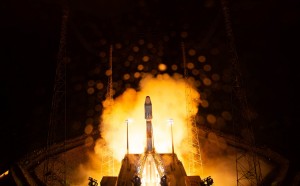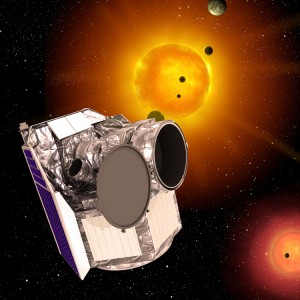Defining Exoplanets
January 8, 2020
Late last year, on Dec. 18, 2019, the European Space Agency (ESA) launched the CHEOPS telescope into space, where it will study the composition of exoplanets. Exoplanets, or extrasolar planets, orbit stars other than our sun. The CHEOPS telescope was launched aboard a Russian-made Soyuz rocket from the Guiana Space Center on the northern coast of South America. CHEOPS—pronounced KAY ops—is an acronym for Characterizing Exoplanets Satellite. If the acronym sounds familiar, Cheops was also the Greek name of the ancient Egyptian king Khufu, who constructed the Great Pyramid at Giza.

A Soyuz rocket carrying the ESA’s CHEOPS telescope lifts off from the Guiana Space Center on Dec.18, 2019. Credit: ESA/S. Corvaja
CHEOPS is small for a satellite, measuring just 5 feet (1.5 meters) long. The craft turns within a polar orbit that allows it to fly between night and day. Its back, covered in solar panels, receives continuous sunshine, while the telescope and camera on the other side is always peering into dark, sunless, and limitless space.

This artist’s impression shows CHEOPS with its back to the sun and the telescope pointed into dark space. Credit: ESA/C. Carreau
The CHEOPS mission is not to discover new exoplanets, but rather to learn more about the exoplanets we already know exist. CHEOPS will study exoplanets larger than our own Earth but smaller than the planet Neptune. Scientists want to know if these intermediate sized exoplanets are more like “super-Earths”—large rocky worlds—or “mini-Neptunes”—small gas giants. By studying an exoplanet’s atmosphere, diameter, mass, and other properties, CHEOPS can determine its composition and whether or not it might be able to support life. Astronomers have discovered over 4,000 exoplanets so far, but there are likely hundreds of billions more to be found.
CHEOPS will use the transit method to study exoplanets. It will aim its camera at a star and capture periodic dips in the star’s light output. These dips occur when an exoplanet passes in front of—or transits—a star in relation to CHEOPS’s point of view.
CHEOPS is a stepping stone between the first exoplanet observatories, such as Kepler and COROT, and the powerful observatories of the near future. The United States National Aeronautics and Space Administration (NASA) James Webb Space Telescope (JWST), scheduled for launch in 2021, will be able to determine the gases present in the atmospheres of some exoplanets and even record low detail images of those gases. The European Southern Observatory’s Extremely Large Telescope (ELT) will also be able to image rocky exoplanets and characterize their atmospheres after it is completed in 2025. The ELT is a ground-based observatory being built in the Atacama Desert of northern Chile. Kepler and COROT prepared the way for CHEOPS, and the JWST and ELT will further examine the most promising CHEOPS targets as scientists continue the hunt for extraterrestrial life.


